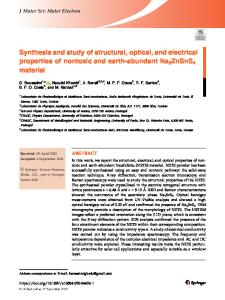Synthesis and X-ray diffraction study of Cu 2 ZnSn(S x Se 1-x ) 4 solid solutions
- PDF / 407,223 Bytes
- 5 Pages / 612 x 792 pts (letter) Page_size
- 53 Downloads / 309 Views
ICAL PROPERTIES OF CRYSTALS
Synthesis and X-Ray Diffraction Study of Cu2ZnSn(SxSe1 – x)4 Solid Solutions A. U. Sheleg, V. G. Hurtavy, and V. A. Chumak State Scientific and Production Association “Scientific-Practical Materials Research Centre of the National Academy of Sciences of Belarus,” ul. P. Brovki 19, Minsk, 220072 Belarus e-mail: [email protected] Received October 22, 2014
Abstract—Quaternary compounds Cu2ZnSnS4 and Cu2ZnSnSe4 and solid solutions on their basis have been fabricated by one-temperature synthesis from elementary components: Cu, Zn, Sn, S, and Se. Single crystals of these compounds have been grown by the method of chemical gas-transport reactions from polycrystalline samples. The compositional dependence of the unit-cell parameters of Cu2ZnSn(SxSe1 – x)4 has been investigated by X-ray diffraction. It is found that parameters a and c linearly decrease with an increase in sulfur concentration in accordance with Vegard’s law. The temperature dependences of parameters a and thermalexpansion coefficients αa of Cu2ZnSnS4 and Cu2ZnSnSe4 single crystals in the range of 100–300 K are determined. DOI: 10.1134/S1063774515040203
INTRODUCTION Silicon, which is widely used in solar light converters, is an indirect-gap semiconductor. This circumstance reduces its conversion efficiency. Currently, silicon is being actively replaced with new materials. Cu(In,Ga)Se2, CuIn(S,Se), and CuGa(S,Se) solid solutions are promising materials for basic layers of light converters. They are direct-gap semiconductors, which, in contrast to silicon, have a large absorption coefficient in the visible and near-IR spectral regions. Currently, the efficiency of solar light converters based on Cu(In,Ga)Se2 solid solutions reaches 19.0–20.8% [1–4]. However, in view of the high cost of indium and gallium and their sparse resources, these metals have begun to be replaced with more inexpensive and available elements. Much attention is paid to quaternary compounds Cu2ZnSnS4 and Cu2ZnSnSe4. These are direct-gap semiconductors, in which In and Ga are replaced, respectively, with Sn and Zn (the closest elements in the Mendeleev periodic table). Recently, there have been many studies on the synthesis, analysis of physical properties, and practical application of materials based on Cu2ZnSnS4 and Cu2ZnSnSe4 compounds and Cu2ZnSn(SxSe1 – x)4 solid solutions [5– 18]. Nevertheless, despite the great efforts and rapid progress in this field in the last few years, the highest photoelectric conversion efficiency of solar cells based on Cu2ZnSnSe4 is only 11.1–12.6% [10, 16]. The reason is that modern technologies do not make it possible to fabricate these materials in the form of thin films
with high structural quality and electrical properties appropriate for solar cells. The synthesis of Cu2ZnSnS4 and Cu2ZnSnSe4 quaternary compounds meets a number of problems, the solution of which may increase the photoelectric conversion efficiency of these materials. One of the main problems is their significant deviation from stoichiometry, which leads to
Data Loading...











